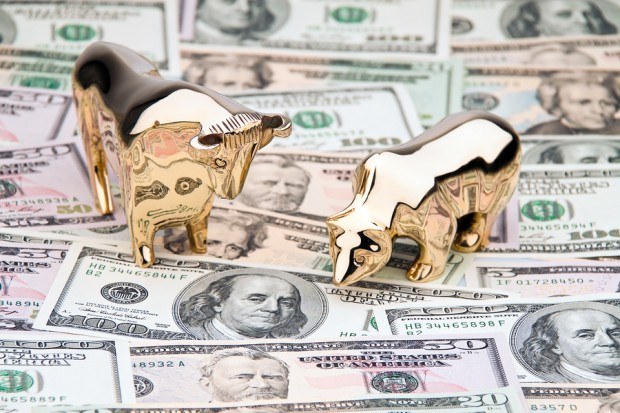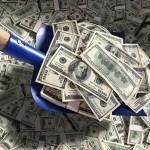For all the dysfunction in Washington we could, it seems, be in the midst of an historic and potentially extended bull run for the U.S. dollar.
The dollar is up a bit less than 4.0 percent over a year against a trade-weighted currency basket, in substantial part because of economic weakness, fragility and radical policy in places like Japan, Europe and Britain.
It is remarkable that we should be entertaining the idea of an extended dollar bull run ahead of “sequestration”— a program of mandatory federal budget cuts that highlights both U.S. fiscal and political weakness.
Currencies are a relative game, however, and things elsewhere, as you may have heard, are not so hot.
The mess that is Italian politics is a timely demonstration that the euro has plenty of fundamental reasons to be weak. And the potential for truly radical monetary policy in Japan under the government of Shinzo Abe indicates that the yen’s fall could be extended and deep.
Britain too may be in the beginning of its third recession in five years and was on Friday stripped of its Aaa credit rating by Moody’s.
So sure, the dollar has some lame competition in the global currency horse race. But a dollar rise, if it comes, will be driven importantly by internal changes which may just be coming into view.
“The U.S. economy is, relatively speaking, in better cyclical and structural shape; the Fed will likely be the first central bank to exit QE,” George Magnus, a senior and often prescient economic advisor to UBS, wrote in a note to clients, referring to quantitative easing policy.
As well, the United States has quite a good story just coming together, with abundant domestic energy, and may well benefit from a transformation in manufacturing technology centered around so-called 3-D printing.
(CM Editor’s Note: Online dictionaries defined 3-D printing, or additive manufacturing, as a process of making a three-dimensional solid object of virtually any shape from a digital model.)
Given that up and down cycles in the dollar usually last six to eight years, Magnus argues that the low the dollar touched in 2008 amid the crisis may be a bottom this time round, implying we might see several years of dollar appreciation from here.
That would clearly have huge implications globally, arguing for potentially difficult conditions for emerging markets, which have a nasty tendency to fall into crises of their own when the dollar rises sharply.
Dollar bears usually cite fiscal pressures as a major negative, arguing either that budget cuts will bring economic weakness or that run-away indebtedness will hobble the economy and spook investors.
There is no doubt the United States is a less good risk than three, five or ten years ago, but then again so is almost every other country.
Investors give the United States a 3.3 percent probability of defaulting over the next five years, according to market prices, making it about one-tenth as likely as Portugal and the fifth least likely country to go bust worldwide. Market prices change quickly but that does imply the United States will be given some time to get to grips with its demographic and budget issues.
It is also clear that the Federal Reserve is at least thinking about what the world after quantitative easing looks like, and may take tentative steps towards tightening monetary conditions over the next year. That actually would likely be dollar positive even if the Fed were doing so because it found the side-effects of QE onerous, and would definitely help if it were in response to a strengthening economy.
Don’t underestimate the power of the energy and manufacturing changes now taking root in the United States. More domestic energy means less money sent overseas and will also tend to make manufacturing at home more internationally competitive. The United States also appears to have substantial strengths in the development of 3-D printing, in which highly customizable objects are literally sprayed into existence. To the extent it develops, 3-D manufacturing will be located close to markets and in places where intellectual property—a large part of a 3-D manufacturer’s value—are well protected.
That kind of good story played a large part in the last big dollar rally, which was driven by the fiscal reforms of the 1990s and, in no small part, by capital flowing to what turned into the technology bubble at the end of the millennium.
One area of concern if the dollar strengthens is the impact on emerging markets. The 1980s dollar rally helped to choke off growth in Latin America, while that of the 1990s led—at least indirectly— to the Asian crisis.
There are clearly huge differences now. Central banks in much of the emerging world have amassed huge dollar reserves, which will help blunt the impact, and many sovereign and corporate borrowers can now raise loans in their home currency, meaning they don’t get squeezed as the dollar rises.
The important thing to remember is that extended rises and falls of the dollar usually end in crisis. We should hope we are yet in the early stages.





















 What Industry Executives Are Saying About Loss Reserves, Social Inflation
What Industry Executives Are Saying About Loss Reserves, Social Inflation  Survey: Majority of CA/FL Homeowners See Rise in Insurance Costs, Coverage Changes
Survey: Majority of CA/FL Homeowners See Rise in Insurance Costs, Coverage Changes  AM Best Downgrades State Farm General Ratings
AM Best Downgrades State Farm General Ratings  La Nina 60% Likely to Develop Between June-August
La Nina 60% Likely to Develop Between June-August 